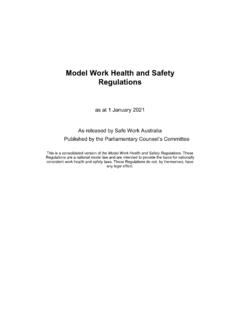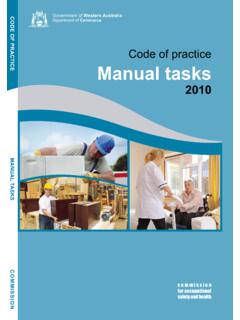Transcription of Model Cop Hazardous Manual Tasks - Safe Work Australia
1 Hazardous Manual Tasks Code of Practice OCTOBER 2018 Disclaimer Safe Work Australia is an Australian Government statutory agency established in 2009. Safe Work Australia includes Members from the Commonwealth, and each state and territory, Members representing the interests of workers and Members representing the interests of employers. Safe Work Australia works with the Commonwealth, state and territory governments to improve work health and safety and workers compensation arrangements. Safe Work Australia is a national policy body, not a regulator of work health and safety. The Commonwealth, states and territories have responsibility for regulating and enforcing work health and safety laws in their jurisdiction.
2 ISBN 978-0-642-33307-0 (PDF) ISBN 978-0-642-33308-7 (DOCX) Creative Commons This copyright work is licensed under a Creative Commons Attribution-Noncommercial International licence. To view a copy of this licence, visit In essence, you are free to copy, communicate and adapt the work for non-commercial purposes, as long as you attribute the work to Safe Work Australia and abide by the other licence terms. Contact information Safe Work Australia | | Hazardous Manual Tasks Code of Practice Page 3 of 71 Contents Foreword .. 4 1. Introduction .. 5 What is a musculoskeletal disorder (MSD)?
3 5 What is a Hazardous Manual task? .. 5 Who has health and safety duties in relation to Hazardous Manual Tasks ? .. 6 What is involved in managing the risk of musculoskeletal disorders? .. 7 2. Identifying Hazardous Manual Tasks .. 11 How to identify Hazardous Manual 11 Characteristics of Hazardous Manual Tasks .. 12 3. Assessing the risks .. 19 When should a risk assessment be conducted? .. 19 How to do a risk assessment for Hazardous Manual Tasks .. 19 What are the risk factors? .. 20 What are the sources of the risk? .. 27 4. Controlling the risks .. 31 The hierarchy of control measures.
4 31 Purchasing to eliminate or minimise risks .. 33 Changing the design or layout of work areas .. 34 Changing the nature, size, weight or number of items handled .. 36 Changing the system of work .. 42 Changing the work environment .. 44 Using administrative control measures .. 46 Implementing control measures .. 47 5. Reviewing control measures .. 49 6. Role of designers, manufacturers, importers and 51 Designers .. 51 Manufacturers, importers and suppliers .. 52 Appendix A Glossary .. 55 Appendix B Examples of controlling MSD risks through design .. 57 Appendix C The risk management process for Manual Tasks .
5 59 Appendix D Hazardous Manual task identification worksheet .. 60 Appendix E Discomfort survey .. 61 Appendix F Risk assessment worksheet .. 62 Appendix G References for further risk assessment methods .. 69 Amendments .. 71 Hazardous Manual Tasks Code of Practice Page 4 of 71 Foreword This Code of Practice on how to manage the risks associated with Hazardous Manual Tasks and control the risks of workers being affected by musculoskeletal disorders is an approved code of practice under section 274 of the Work Health and Safety Act (the WHS Act). An approved code of practice provides practical guidance on how to achieve the standards of work health and safety required under the WHS Act and the Work Health and Safety Regulations (the WHS Regulations) and effective ways to identify and manage risks .
6 A code of practice can assist anyone who has a duty of care in the circumstances described in the code of practice. Following an approved code of practice will assist the duty holder to achieve compliance with the health and safety duties in the WHS Act and WHS Regulations, in relation to the subject matter of the code of practice. Like regulations, codes of practice deal with particular issues and may not cover all relevant hazards or risks . The health and safety duties require duty holders to consider all risks associated with work, not only those for which regulations and codes of practice exist. Codes of practice are admissible in court proceedings under the WHS Act and WHS Regulations.
7 Courts may regard a code of practice as evidence of what is known about a hazard, risk, risk assessment or risk control and may rely on the code in determining what is reasonably practicable in the circumstances to which the code of practice relates. For further information see the Interpretive Guideline: The meaning of reasonably practicable . Compliance with the WHS Act and WHS Regulations may be achieved by following another method if it provides an equivalent or higher standard of work health and safety than the code. An inspector may refer to an approved code of practice when issuing an improvement or prohibition notice.
8 Scope and application This Code is intended to be read by a person conducting a business or undertaking (PCBU). It provides practical guidance to PCBUs on how to manage health and safety risks associated with musculoskeletal disorders arising from Hazardous Manual Tasks in the workplace. This Code may be a useful reference for other persons interested in the duties under the WHS Act and WHS Regulations. This Code applies to all workplaces covered by the WHS Act where Hazardous Manual Tasks are carried out. How to use this Code of Practice This Code includes references to the legal requirements under the WHS Act and WHS Regulations.
9 These are included for convenience only and should not be relied on in place of the full text of the WHS Act or WHS Regulations. The words must , requires or mandatory indicate a legal requirement exists and must be complied with. The word should is used in this Code to indicate a recommended course of action, while may is used to indicate an optional course of action. Hazardous Manual Tasks Code of Practice Page 5 of 71 1. Introduction Most jobs involve carrying out some type of Manual task using the body to move or hold objects, people or animals. Manual Tasks cover a wide range of activities including stacking shelves, working on a conveyor line and entering data into a computer.
10 Some Manual Tasks are Hazardous and may cause musculoskeletal disorders (MSD). These are the most common workplace injuries across Australia . What is a musculoskeletal disorder (MSD)? The term MSD refers to an injury to, or a disease of, the musculoskeletal system, whether occurring suddenly or over time. It does not include an injury caused by crushing, entrapment or cutting resulting from the mechanical operation of plant. An MSD may include: sprains and strains of muscles, ligaments and tendons back injuries, including damage to the muscles, tendons, ligaments, spinal discs, nerves, joints and bones joint and bone injuries or degeneration, including injuries to the shoulder, elbow, wrist, hip, knee, ankle, hands and feet nerve injuries or compression, for example carpal tunnel syndrome muscular and vascular disorders as a result of hand arm vibration soft tissue injuries including hernias, and chronic pain.












